The sites, bites, and characters that make Palermo one of the most under-appreciated cities in the world
Palermo is not one of the grand cities of the world. It doesn’t have the history of Rome, the charm of Paris, the energy of New York. It doesn’t even have the population of El Paso. But greatness is often defined by what’s missing, and what Palermo doesn’t have could fill an article: rainy weather, long lines, exorbitant prices, an inflated sense of self. And don’t expect that to change too soon: with three thousand years of history behind it, Palermo isn’t the type of place that tolerates abrupt pivots.
That’s not to say the Sicilian capital is static. Most locals will tell you that change is afoot, particularly in the old part of town. Suddenly boutique hotels have sprouted up, decaying palazzi have been restored, a few restaurants have started cooking food that isn’t Italian.
But you don’t come to Palermo to stay in minimalist hotels and eat sesame-speckled tuna rolls; you come to Palermo to be in Palermo, to drink espressos as dark and thick as crude oil, to eat thick tangles of spaghetti bathed in buttery sea urchin, to wander the streets at night, feeling perfectly charmed on one block, slightly concerned on the next. To get lost. After a few days, you learn to turn down one street because it smells like jasmine in the morning; you learn to avoid another street because in the heat of the afternoon it smells like swordfish three days past its prime.
You come here because everyone wants to pretend, for a few days at least, that they are Italian, and there is no easier city to do that in than Palermo. You can walk the markets without bumping shoulders with other tourists, eat ice cream, like a Sicilian, at any hour of the day, have a late dinner down an alley cast in an orange summer glow. Rent an apartment on a narrow street in the old city and hang your wet clothes from the balcony. Before you pack your bags and catch that flight back to Cork or Colorado or Copenhagen, you can have one last lemon granita at the sidewalk café that has quickly become your second home in Palermo and think to yourself: “So this is what it would be like.”
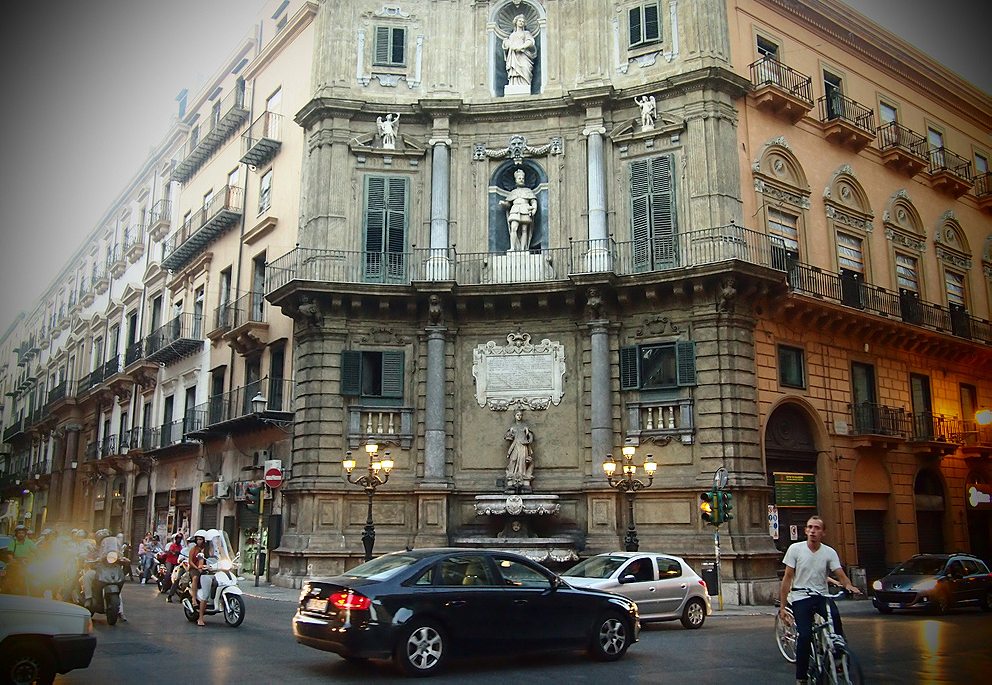
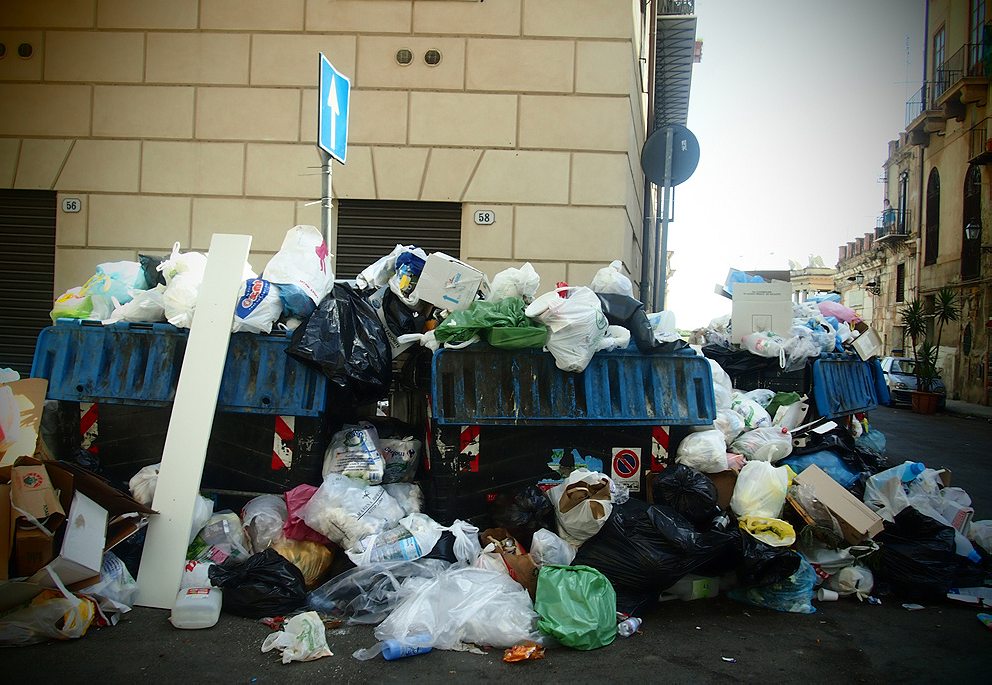
Over the past 3000 years, Palermo, like Sicily itself, has been passed around like a giant doobie among history’s most fiendish conquerors: from the Phoenicians to the Greeks, from the Greeks to the Carthaginians, from Hannibal’s men to the legions of the Roman Empire. Everyone took a toke: the Muslims, who laid siege to Sicily in the 9th century and made Palermo a capital on scale with Cordoba and Cairo; the Spaniards, who ruled the island for nearly 300 years during the height of their empire; the Normans, who spent great sums of money ushering in an era of ostentation and hedonism before abandoning the island 400 years later.
Eventually the great general Giuseppe Garibaldi, sailing down from Genoa with just 1,000 men, liberated Sicily from the Bourbons and set it on a path to become a part of the new Kingdom of Italy, as the country of Italy as we know it now unified in 1861.
But Palermo’s history as a receptacle for tragedy and invader angst didn’t end there. Even in unified Italy, it was something of a neglected stepchild. And in 1943, the Allies, led by American warplanes, laid siege to the city, bombing its port and its old quarter back into the 16th century. In the wake of the war, with the country in ruins, the Mafia found ways to exploit the island’s gripping poverty and torpid reconstruction, transforming the Costa Nostra from a countryside collective to a powerful urban organism. (The fact that the Mafia and the Allies had, by some reports, a working relationship during the war only further solidified their holdings across Sicily.)
For the last half of the 20th century, Palermo served as the seat for organized crime across Italy as the city descended into a bubbling cauldron of assassinations, citizen shakedowns and crippling government corruption. Law officials estimate that 80% of businesses still pay “protection” fees to the Mafia, but the efforts of brave judges and angry citizens and organizations like Addio Pizzo, a group who stand firmly against mafia kickbacks (“pizzo”) have crippled the Cosa Nostra in ways it is unlikely to ever recover from.
Today, Palermo wears the marks of its many rulers over the past two millennia: Greek columns and Roman arches, couscous and currants, bombed-out buildings and corner-store kickbacks. Now, finally, Palermo is free—at least as free as it’s ever been.
By 8 am, the pieces are set and the city begins its daily feast.
Palermo first stirs in Ballaró. In the brown moments before dawn, cargo vans and trucks wind their way down its narrow streets. By first light, immigrants haul crates of melons and buckets of ice over the cobblestone. By 8 am, the pieces are set and the city begins its daily feast.
Ballaró is Palermo’s largest market, and one of the most instantly endearing street scenes you’ll find anywhere. Old men sell salted capers and branches of wild oregano while the young ones go about building their fish stands, one body at a time, like an edible art installation. It’s a startling scene: gruff young Palermitani, foul-mouthed and wreathed in cigarette smoke, lovingly laying out every fish at just the right angle, burrowing their bellies into the ice as if to mimic its swimming position in the ocean. Every last piece sparkles in the morning sun, eyes clear and bright, and for a long moment, you may contemplate buying one of those gorgeous sea bass and eating it like an apple.
A more realistic purchase would be a kilo of the smallest, brightest cherry tomatoes you can find for snacking as you go from stall to stall. Later, buy the biggest, darkest jar of pomodoro concentrato—tomato paste—to take home with you. Dark as rust and dense as caulk, with the taste of a hundred tomatoes in every tablespoon, it alone will improve your Italian cooking by 25 percent.
On the fringes of the market you will find bars serving pane e panelle, fried wedges of chickpea combined with potato fritters and stuffed into a roll the size of a catcher’s mitt. This is how the vendors start their days; this is how you should start yours, too.
In fact, much of what you do in Palermo will involve eating more than you probably should. “A person eating must make crumbs,” goes one of the great Palermo proverbs, and this city makes its crumbs in all shapes and sizes.
This type of blunt street food is a source of passion and pride in Palermo.
Palermo is dotted everywhere with frittura shacks—street carts or storefronts specializing in fried foods of all shapes and cardiac impact. Ganci is among the city’s most beloved, a sliver of a store offering more calories per square foot than anywhere I’ve ever eaten. You can smell the mischief afoot a block before you hit the front door: pizza with french fries and fried eggplant, fried rice balls stuffed with ham and cubes of mozzarella, and a ghastly concoction called spiedini which involves a brick of béchamel and meat sauce coated in breadcrumbs and fried until you could break someone’s window with it. A hundred meters down the road you’ll find a handful of fruit stands with artful produce arrangements and spinning cylinders of fresh juice to wash away your sins.
This type of blunt street food is a source of passion and pride in Palermo. Take another local favorite: pane con la milza, beef spleen stewed in lard, then stuffed into a roll slathered with more lard and topped with grated caciocavallo cheese. Focacceria San Francesco serves up the oldest version in the city, along with other great Sicilian classics, but most prefer the sandwich from Pani Ca’ Meusa near the port. Regardless of where you buy it, eat it fast; as it cools, it becomes more and more apparent that you are eating a spleen burger.
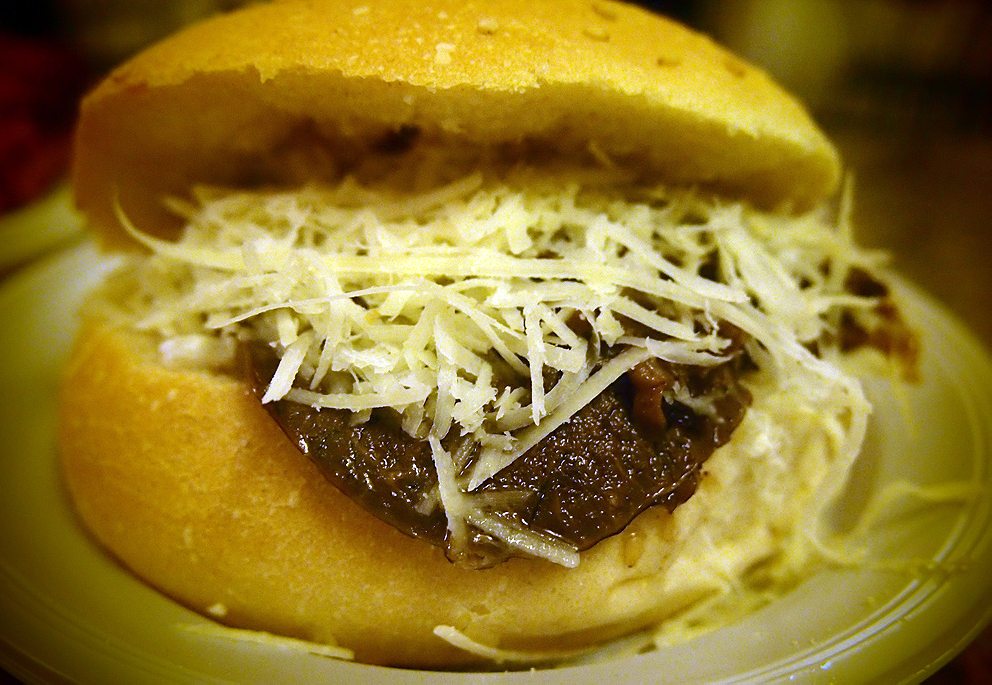

Gelato serve as the city’s collective palate cleanser, and a scoop shop is never more than a few blocks away. Bar Gelateria Ilardo Giovanni down on the water is open until 2 am and on a balmy summer night might be the most popular seat in town. Young lovers canoodle on benches and kids run circles around families planted in plastic chairs around the patio.
The ice creams are tremendous—smooth, supple, impossibly dense with flavor—but in the freezer on the left you’ll find the star of the show: two thin biscotti stuffed with pea-green pistachio ice cream and covered in a layer of dark chocolate. (If you don’t return the next morning for a breakfast ice cream sandwich, then you are a stronger soul than I am.)
All of this could feel too much like a caricature of a Sicilian trattoria, if the food itself wasn’t so damn good.
But for all the vats of oil, bubbling béchamel and sweetened cream, the heart of Palermitani food is to be found in its trattorias, those bastions of simple, satisfying, inexpensive cooking strewn all throughout the city. At Zia Pina, you will find no menu at all, just old Zia cooking up great piles of stuffed sardines and baby octopus and fried red mullet. At Trattoria Basile, you take your ticket and build your meal piece by piece: a few stuffed eggplant, a plate of spaghetti and calms, maybe a bit of grilled sausage. If you can eat more than 5€ worth of food, then you may secretly be Sicilian.
Palermo and cool don’t collide often in the same sentence, but when you’re at Kursaal Kalhesa, sipping a Negroni downstairs while reading through their library of cookbooks and philosophical tomes, it’s hard not to feel that maybe this will change one day. Housed inside the city’s ancient fortress wall, Kursaal also has an upstairs alfresco trattoria where dishes like zucchini flan and swordfish entombed in crushed pistachio offer a taste of tomorrow—gentle nudges forward, but relatively radical by Palermo standards.
The reason the trattoria is so important to Sicilians, though, has little to do with the food itself. It’s because meals here are meant to be stretched out over the course of hours, and the trattoria format—appetizers followed by pasta followed by a main course, all soaked in bottles of inexpensive wine—makes a marathon meal feel like a leisurely jog. One of the best meals I ate in Palermo was a three-hour bacchanalia with a pair of Sicilians at the bustling Ferro di Cavallo on Via Venezia. Waiters pressed glasses of prosecco into the palms of young Palermitani gathered out front. Streetlights cast a gentle glow over the sidewalk tables. Menus came printed directly on the tablecloths: 4€ for antipasti, 5€ for pasta, 7 € for meat and fish.
All of this could fall flat, feel too much like a caricature of a Sicilian trattoria, if the food itself wasn’t so damn good: arranciette, saffron-scented rice fried into crunchy, greaseless golf balls; polpette di pesce de spada, swordfish meatballs with a taste so deep and savory they might as well be made of dry-aged beef; and a superlative version of caponata, that ubiquitous Sicilian starter of eggplant, capers and various vegetation, stewed into a sweet and savory jam that you will want to smear on everything.
…Chewy noodles tinted jet black with squid ink and tossed with sautéed rings and crispy legs of calamari
The pasta: even better. Chewy noodles tinted jet black with squid ink and tossed with sautéed rings and crispy legs of calamari—a sort of nose-to-tail homage to the island’s cherished cephalopod. And Palermo’s most famous dish, pasta con le sarde, a bulge of thick spaghetti strewn with wild fennel, capers, raisins, and, most critically, a half dozen plump sardines slow-cooked until they melt into a briny ocean ragu. Sweet, salty, fatty, funky—Palermo in a single bite.
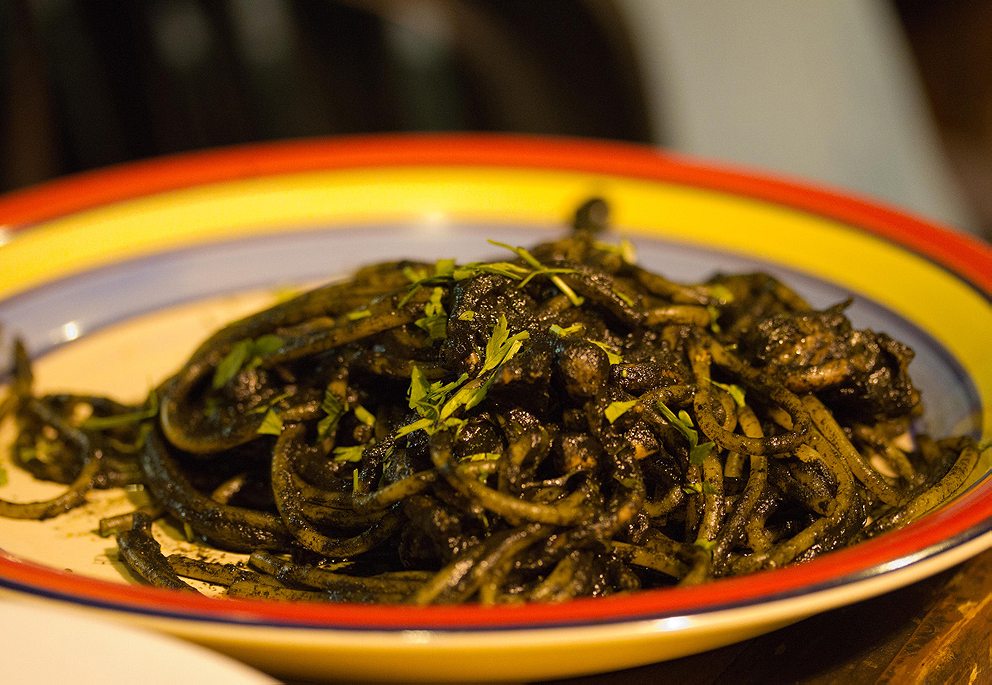
And yet somehow, even with this lovely bounty before us, the food was overshadowed by the conversation at our table. As we plodded our way through the meal, Alessio Genovese, a Sicilian journalist from nearby Trapani, talked to us about Palermo’s immigration issues, about Sicily’s ambivalent relationship with the rest of Italy, about the micro-dialects and cuisines found all over the island. “You can move from one village to the next and find the food and the language have changed completely.”
Four times the server came by to pick up the plate of pasta and four times she was sent back empty handed—each time with an increasingly intense waggle from Genovese’s finger. The two Americans at the table, we had put our forks down an hour earlier, but the two Sicilians pushed forward, eating, drinking and talking in such a perfectly balanced manner that time seemed to stop moving altogether. The oil from a pasta, the last drops of wine, the final thought in a conversation: crumbs are precious in Palermo and they will be eaten, with the tines of a fork, the heel of a baguette, or the tip of an index finger.
You can seek out market life in the morning and death in the afternoon.
That’s not to say you can’t, you know, do something while you’re in Palermo beyond binging. You can tour the city’s magnificent churches and museums—from the grand mosaics and golden walls of Capella Palatina to the jumble of arches and angles and foreign influences reflected in the central cathedral—and make a down payment on the gluttony Palermo is sure to provoke. You can retreat to the shores either side of town, to posh places like Mondello, where the mentholated waters of the Tyrrhenian will accept your bloated body without judgment, just as it does its Sicilian sons and daughters. You can take in a show at Teatro Massimo, just as Michael Corleone did at the end of the Godfather Trilogy, and hope that your night goes a bit better than his.
You can seek out market life in the morning and death in the afternoon. At the Catacombe dei Cappuccini, you’ll find 8,000 corpses fully dressed, some disconcertingly well preserved, their final thoughts still stained to their faces. What began as a traditional burial ground for friars in the 16th century soon turned into a status symbol for wealthy Sicilians who learned of the catacomb’s uncanny ability to preserve bodies; 2 year old Rosalia Lombardo, the last body to be buried here 92 years ago, looks like she just laid down for a nap.
For a more contemporary reminder of the tragedies trapped within this city, look to the memorials for those who have given their lives fighting the mafia: one, a sleek black marble column in central Palermo for all of those who have died, the other, just outside of town in Capaci, for one man, judge Giovanni Falcone, the patron saint of the anti-Mafia movement, who dealt a critical blow to organized crime in Sicily during the Maxi trials of the 1980s. Falcone traveled with three bodyguards and talked openly about his imminent death; Toto Riina, ruthless mob boss, was all too happy to oblige. Riina had a half-ton bomb planted on the highway outside of Palermo, which blew Falcone, his bodyguards, and his wife out of existence.
In the months and years to follow, the murders of Falcone and fellow crusader Paolo Borsellino served to galvanize Sicilians, turning popular sentiment against the often-romanticized thugs and murders of the mob—a reminder that even death has a certain vitality in this town.
To fall under the Palermo spell, you don’t need a map or dinner reservations or a cryptic reminder of the fragility of life. You just need to move your feet.
But to fall under the Palermo spell, you don’t need a map or dinner reservations or a cryptic reminder of the fragility of life. You just need to move your feet. In the waning moments of the afternoon, light splinters its way through every orifice in the old part, shooting through cracks, bending around corners, slipping through the great stone arches at the edge of the port. Follow the light and see where it leads you.
It will take you past a street corner where men gather to eat handfuls of stewed beef innards from clandestine street carts. (Don’t fill up before dinner!) Past the window of a workshop on Via Aprile IV, where inside an old man with wild hair whittles wood into magnificent little toys. (No pictures! an exasperated sign reminds you.) On to Via Alessandro Paternostro, to places like Bar Salvatore, where people fill the streets in the early hours of the evening for aperitivo, that much beloved Italian way to warm up for dinner with free bar snacks and booze. (Make it a spritz—prosecco, Aperol and soda water, the closest thing to Sicilian dusk in a glass.)
It’s not all postcard pretty, of course. Much of Palermo can feel like an archeological dig suddenly suspended: ancient buildings roped off and abandoned, corridors of plywood that stretch on without meaning. On the street corners of even the nicest parts of the city’s historic district, you’ll find garbage stacked up in mountains of stench and decay—a byproduct of southern Italy’s penchant for strikes, labor disputes, and Mafia mischief-making. When I walked by one such prodigious pile on Via Butera, one of Palermo’s most elegant streets, and snapped a photo, a man in an apron came out of the corner bar and barked at me: “Great, there you go. A beautiful memory of Palermo.”
By now you probably need another drink. If you’re up past midnight and thirsty, you’ll find your way to the Vucciría—a small plaza with a few snaking tributaries where the city funnels its hungriest and thirstiest citizens. During the day, when the Vucciría market stalls line the streets, pushing everything from swordfish to Grana Padano to fake Prada, you can slip in to Taverna Azzurra, sip a 1€ glass of Marsala from the bodega barrel, and watch the old men talk about Berlusconi and Serie A in a language no other Italians would understand. (Sicilians—Palermitani in particular—speak a dialect that bears only a passing resemblance to the language spoken on the mainland.)
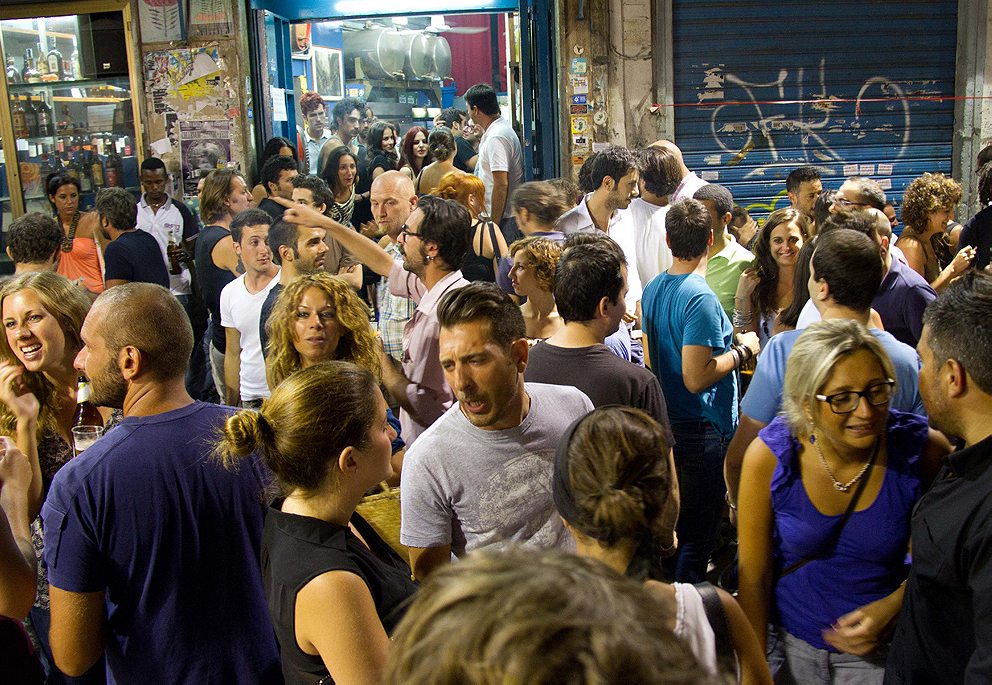
But on a weekend night you’ll find the plaza transformed into a pulsating street party. There is no apparent order: drinks appear magically, music arrives from sources unknown, and smoke, a mixture of charred crustaceans and African hash, hangs thick in the air as throngs of young, drunk Palermitani and a few lucky visitors push the night to its breaking point.
Palermo doesn’t seem like the Cinderella type. It’s had 3,000 years to construct a heart-warming comeback narrative, so why all of a sudden now?
“Palermo is changing. You can see it everywhere,” says Nicoletta Polo, the Duchess of Palma. We’re sitting in the patio gardens of the 17th century Palazzo Lanza Tomasi, the former palace of Giuseppe di Lampedusa. He lived upstairs in the 1950s as he went from café to café in Palermo, stitching together the scenes that would finally become one of the great masterpieces of Italian literature, The Leopard.
Now Lampedusa’s adopted son Gioacchino and Nicoletta have converted the extra apartments into Butera 28, one of Palermo’s finest accommodations: The place I rented has two bedrooms, a balcony, and a speedy wifi connection for 70€ a night. (Did I mention that Palermo is insanely cheap compared to the rest of Western Europe?) This type of luxury is new in these parts.
“Thirty years ago when I arrived Palermo looked as if the war had just finished. Most people had moved into the new part of town. The old part was abandoned,” she tells me. “Now we’re seeing the rebirth of the historic center. Architects, artists, contractors are all buying and refurbishing this area.”
It makes for a great story, one you’ve probably read before: an ancient city that had fallen into disrepair suddenly rising like a phoenix from the ashes of its former self. But I’m not sure I’m buying it. Palermo doesn’t seem like the Cinderella type. It’s had 3,000 years to construct a heart-warming comeback narrative, so why all of a sudden now?
I wish the Duchess the best and take to the street. It’s my last night in Sicily and I want to wander one last time. I find the scenes that I’ve grown to love so quickly, so thoroughly, waiting for me outside: tables of old women playing cards in the park, a young couple making out on the steps of a church, a street stand with a man splitting live sea urchins open with a pocket knife.
But when I round the final bend heading back to my apartment, I’m met with a sight I haven’t seen all week: a garbage truck. Men in brightly colored uniforms are busy disassembling a mountain of trash piece by piece. People have wandered out from their apartments, pulled over on their scooters, stepped out onto their balconies to see what these strange men in jumpsuits are doing. And when the truck finally moves on to another great pile, leaving a perfect cobblestone street corner framed by an amber glow in its wake, the Palermitani shrug their shoulders and turn back to doing whatever they were doing before.
****
Where we ate:
Antica Focacceria San Francesco
Via Alessandro Paternostro, 58
091 320264
Daily except Tuesday: 1:00–3:00 pm, 8:00–11:00 pm
Ganci
Via Paolo Paternostro, 64
389 5103444
“Open every day until late at night”
Pani cà Meusa
Via Cala, 62
+39 091 323433
Daily: 7am-10pm
Bar Gelateria Ilardo Giovanni
Foro Umberto I, 11
+39 3387499757
Daily until 2am
Zia Pina
Via Argenteria, 67
Daily for dinner
Trattoria Basile
via Bara All’Olivella, 76
+39 091 335628
Lunch only. Open Monday-Saturday: 12p-3:30p
Kursaal Kalhesa
Foro Umberto I, 21
+39 091 616 0050
Tuesday-Saturday 12p-3p, 7p-1:30a
Sunday 12p-1:30a
Closed Monday
Ferro di Cavallo
Via Venezia, 20
091 331835
Monday-Saturday 10a-3:30p, 7:45p-11:30p (Monday-Tuesday dinner is in August only)
Closed Sunday
Bar Azzurra
Via Maccheronai, 15 (Vucciria)
Open late daily
Where we stayed:
Butera 28
Via Butera 28for
+39 333 3165432
Food markets:
Ballaró market
Via Ballaró
Vucciria
Via Coltellieri
Mercato di Capo
From Porta Carini to Piazza Beati Paoli